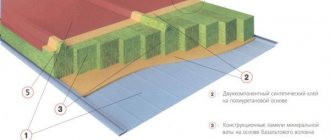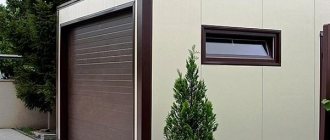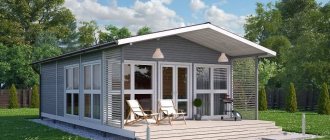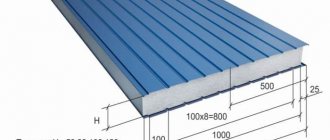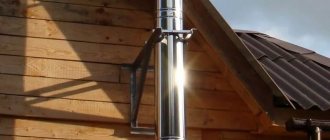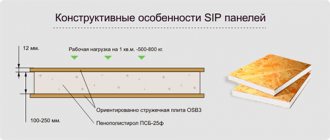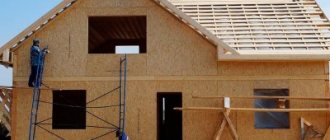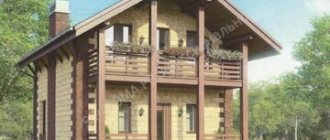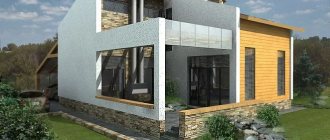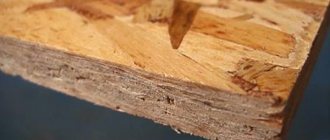Choosing “your” thermal insulation is quite simple. You just need to know what to look for - that is, which material characteristics are the most important.
Choosing insulation: key properties of the material
The modern thermal insulation market is very large, so choosing a material from various options can seem like a really difficult question to an inexperienced person. However, no matter what proposals we come across, be it mineral wool, polystyrene-based products - XPS and EPS, well-known “eco-friendly” materials like sheep wool or hemp, or PIR insulation boards - the set of key characteristics will always be the same.
Thermal conductivity
This is the main indicator of insulation quality - the ability of the material to maintain the required temperature inside the thermal circuit. The lower, the more correct - in the case, for example, with PIR, it can be argued that now this insulation has no equal in the Russian thermal insulation market: its thermal conductivity coefficient λ25 = 0.021 W/mK (we are talking about PIRRO PIR-boards produced by the Russian company PirroGroup) is a record (for comparison: the corresponding characteristic of polystyrenes is about 0.037 W/mK, mineral wool is 0.039).
Durability
How long will this material last under these operating conditions before losing its thermal insulation properties? The answer includes many subparagraphs: how does the insulation withstand mechanical loads, is it strong in compression and bending? How does it tolerate exposure to water, high and low temperatures? Do mice and insects damage it? If we talk about PIR panels, the characteristics allow this material to last over 50 years, in which it is superior to the products of many manufacturers. Traditional insulation materials have less durability, as does the range of applications: for example, fragile fibrous materials are not suitable for insulating existing roofs, and polystyrenes do not tolerate high temperatures and cannot be used in baths and saunas.
Fire resistance
Fire is the greatest danger threatening a building, so all construction materials must be as non-flammable as possible. A positive example of thermal insulation is PIR insulation, whose thematic characteristics include the ability not to support or spread combustion (if the flame source is removed from the stove, its surface goes out). Unlike some traditional materials, when exposed to fire and extremely high temperatures, PIR panels do not release toxic chemicals.
Environmental friendliness
This indicator is important not only for conservationists: each of us needs a safe and clean environment. Let us once again note PIR thermal insulation boards, whose characteristics give us the right to call this material environmentally friendly. It is chemically stable: all reactive processes are completed before the product reaches the consumer. The production of PIR panels does not spoil the air, soil, or water, and used products can be recycled. These polyurethanes are supplied, among other countries, to European countries and the USA - precisely as the most environmentally friendly thermal insulation materials.
Safety for human health
Note that polyisocyanurate, which is, in fact, an improved modern version of the most popular polyurethane polymer, does not pose any threat to human health and can be used even in such specific rooms as bedrooms, children's rooms and catering units. The best proof of this is that hypoallergenic and non-reactive polyurethane is actively used in the production of medical equipment and components, and in the manufacture of consumables - for example, catheters and gloves. It is also included in implants for use in dentistry, cardiac surgery, mammoplasty and other branches of practical medicine.
Section Contents
1. Sandwich panels made of polyisocyanurate foam (PIR) 1.1 What is polyisocyanurate foam? 1.2 Technical characteristics of PIR sandwich panels 1.3 Fire safety indicators of polyisocyanurate foam 1.4 Comparison of polyisocyanurate foam with mineral wool 1.5 Main advantages of sandwich panels with PIR insulation 1.6 Area of use of PIR panels 1.7 Prices for PIR sandwich panels 1.7.1 Cost of wall sandwich panels PIR 1.7. 2 Cost of PIR roofing sandwich panels 2. Polyurethane foam sandwich panels (PUR, PUR) 2.1 Technical characteristics of PUR sandwich panels 2.2 Scope of PUR panels 2.3 Prices for PUR sandwich panels 2.3.1 Cost of PUR wall sandwich panels 2.3 .2 Cost of PPU (PUR) roofing sandwich panels 3. Dimensions of PIR/PUR panels 4. Locking connection of PIR/PUR wall panels 5. Locking connection of PIR/PUR roofing panels 6. Covering of PIR/PUR sandwich panels 7. Sandwich packaging PIR/PUR panels 8. PIR/PUR sandwich panels to order
A little about the company
The company began its history in 1992. In less than 30 years, the company has grown into a powerful corporation producing building materials for various purposes. Today TechnoNIKOL is a leading European manufacturer of highly efficient and reliable building materials and systems. This result became possible thanks to the symbiosis of world experience with our own scientific developments.
Products are manufactured at 53 factories in 7 countries: Russia, Belarus, Great Britain, Germany, Italy, Lithuania and the Czech Republic. The production company's products are supplied to 95 countries worth about 1.5 billion US dollars per year (103.7 billion rubles in 2022).
The basis for the progressive development of the corporation:
- constant search in scientific centers for new types of materials;
- introduction of advanced technologies;
- training builders in innovative technologies for using cutting-edge materials.
All of the above also applies to the subject of our excursion - TechnoNIKOL brand insulation.
Sandwich panels made of polyisocyanurate foam (PIR)
PIR sandwich panels are a reliable building material, which is distinguished by its three-layer structure and low weight. Its main advantage is fire resistance .
Also, the main advantages of this insulation are its low thermal conductivity coefficient and good load-bearing capacity .
Therefore, this insulation is used in the production of sandwich panels as one of the main ones.
1.1 What is polyisocyanurate foam?
Polyisocyanurate foam (PIR) is a modified polyurethane foam (PPU) , which has a number of serious advantages over its predecessor.
PIR is also made on the basis of the reaction of a polyol and isocyanate, however, the presence of fire retardants in its structure makes the insulation self-extinguishing after the combustion source is removed.
In addition, PIR works much better in tension-compression . It can be used in places where these characteristics are subject to special requirements, for example, structures experiencing increased wind loads.
1.2 Technical characteristics of PIR sandwich panels
| Indicator name | Meaning | |||||||||||
| Filler type | polyisocyanurate foam (PIR) | |||||||||||
| Average density, kg/m3 | 42 | |||||||||||
| Weight, kg/m2 with metal thickness 0.5 mm | wall | 9,5 | 11,6 | 12,4 | 13,2 | 14,5 | 16,6 | |||||
| roofing | 9,8 | 11,5 | 12,3 | 13,1 | 14,4 | |||||||
| Metal thickness, mm | 0,50-0,70 | |||||||||||
| Metal surface, mm | profiled or smooth | |||||||||||
| Standard version | RAL 9003 or Zn (galvanized sheet) | |||||||||||
| Thermal conductivity coefficient, W/m K | 0,022 | |||||||||||
| Thermal resistance coefficient | Wall | 1,9 | 3,81 | 4,76 | 5,71 | 7,14 | 9,52 | |||||
| Roofing | 2,0 | 3,9 | 4,86 | 5,81 | 7,24 | |||||||
| Sound insulation, dB | 35 | |||||||||||
1.3 Fire safety indicators of polyisocyanurate foam
| Indicator name | Filler | 40 | 60 | 80-120 | 150-200 | Standard |
| Fire resistance limit of wall panels | PUR | EI15 | GOST 30247.1-94 | |||
| PIR | EI15 | EI30 | EI45 | GOST 30247.0-94 | ||
| Fire resistance limit of roofing panels | PIR | RE15 | RE30 | RE30 | GOST 30247.0-94 GOST 30247.1-94 | |
| Fire hazard class | PIR | K1 (15) | GOST 30403-96 | |||
| Flammability group | PIR | G1 | GOST 30244-94 | |||
| Flammability group | PIR | IN 1 | GOST 30402-96 | |||
| Smoke generating ability | PIR | D3 | GOST 12.1.044-89 | |||
| Combustion Products Toxicity Group | PIR | T2 | GOST 12.1.044-89 | |||
| Surface flame propagation group | PIR | RP1 | GOST R 51032-97 | |||
1.4 Comparison of polyisocyanurate foam with mineral wool
| Properties | FEAST | Mineral wool |
| Density, kg/m3 | 40-50 | 115-200 |
| Thermal conductivity coefficient, W/m°C | 0,022 | up to 0.052 |
| Moisture absorption in 24 hours at 96% relative humidity, volume % | 0,01 | > 0,2 |
1.5 Main advantages of sandwich panels with PIR insulation
- Good fire resistance of PIR sandwich panels - they can be used at elevated temperatures (max t for PPU – +100°C, max t for PIR – +150°C).
- Easy to install PIR sandwich panels due to their low weight. The reduction in the weight of the insulation is ensured by the thermal insulation properties of the material, which make it possible to minimize its thickness.
- High strength characteristics and load-bearing capacity. PIR is excellent for insulating structures that experience high loads (for example, concrete-cement screed).
- Low thermal conductivity coefficient (0.022 W/m*K). In this indicator, polyisocyanurate foam greatly outperforms many similar materials.
- Environmental Safety. Polyisocyanurate foam does not emit hazardous substances and does not provoke allergic reactions.
1.6 Area of use of PIR panels
Sandwich panels with polyisocyanurate foam insulation are successfully used for wall installation in buildings for a wide variety of purposes:
- Shopping and entertainment centers;
- Car washes;
- Food or any other “clean” production premises;
- Swimming pools, sports grounds;
- Warehouses, hangars;
- Storage facilities for hazardous substances;
- Industrial workshops;
- Etc.
1.7 Prices for PIR sandwich panels
1.7.1 Cost of PIR wall sandwich panels, rubles. per square meter, depending on the thickness and type of polymer coating of the metal
| Coating material | Panel thickness, mm / Joint type (tongue and groove) | ||||||||
| single | double | triple | |||||||
| Side A | Side B | 40 | 50 | 60 | 80 | 100 | 120 | 150 | 200 |
| Fire resistance limit | EI15 | EI30 | EI45 | ||||||
| Ral | |||||||||
| Ral | 1472 | 1575 | 1674 | 1873 | 2068 | 2282 | 2589 | 3147 | |
| Zn | 1452 | 1555 | 1654 | 1853 | 2048 | 2262 | 2569 | 3127 | |
| Aisi 304 | 2752 | 2855 | 2954 | 3153 | 3348 | 3562 | 3869 | 4427 | |
| AISI 430 | 2272 | 2375 | 2474 | 2673 | 2868 | 3082 | 3389 | 3947 | |
| PVDF | 1682 | 1785 | 1884 | 2083 | 2278 | 2492 | 2799 | 3357 | |
| PuralFarm | 1897 | 2000 | 2099 | 2298 | 2493 | 2707 | 3014 | 3572 | |
| granite farm | 1897 | 2000 | 2099 | 2298 | 2493 | 2707 | 3014 | 3572 | |
| Food Safe | 2072 | 2175 | 2274 | 2473 | 2668 | 2882 | 3189 | 3747 | |
| Zn | |||||||||
| Ral | 1452 | 1555 | 1654 | 1853 | 2048 | 2262 | 2569 | 3127 | |
| Zn | 1432 | 1535 | 1634 | 1833 | 2028 | 2242 | 2549 | 3107 | |
| Aisi 304 | 2732 | 2835 | 2934 | 3133 | 3328 | 3542 | 3849 | 4407 | |
| AISI 430 | 2252 | 2355 | 2454 | 2653 | 2848 | 3062 | 3369 | 3927 | |
| PVDF | 1662 | 1765 | 1864 | 2063 | 2258 | 2472 | 2779 | 3337 | |
| PuralFarm | 1877 | 1980 | 2079 | 2278 | 2473 | 2687 | 2994 | 3552 | |
| granite farm | 1877 | 1980 | 2079 | 2278 | 2473 | 2687 | 2994 | 3552 | |
| Food Safe | 2052 | 2155 | 2254 | 2453 | 2648 | 2862 | 3169 | 3727 | |
| Aisi 304 | |||||||||
| Ral | 2752 | 2855 | 2954 | 3153 | 3348 | 3562 | 3869 | 4427 | |
| Zn | 2732 | 2835 | 2934 | 3133 | 3328 | 3542 | 3849 | 4407 | |
| Aisi 304 | 4032 | 4135 | 4234 | 4433 | 4628 | 4842 | 5149 | 5707 | |
| AISI 430 | 3552 | 3655 | 3754 | 3953 | 4148 | 4362 | 4669 | 5227 | |
| PVDF | 2962 | 3065 | 3164 | 3363 | 3558 | 3772 | 4079 | 4637 | |
| PuralFarm | 3177 | 3280 | 3379 | 3578 | 3773 | 3987 | 4294 | 4852 | |
| granite farm | 3177 | 3280 | 3379 | 3578 | 3773 | 3987 | 4294 | 4852 | |
| Food Safe | 3352 | 3455 | 3554 | 3753 | 3948 | 4162 | 4469 | 5027 | |
| AISI 430 | |||||||||
| Ral | 2272 | 2375 | 2474 | 2673 | 2868 | 3082 | 3389 | 3947 | |
| Zn | 2252 | 2355 | 2454 | 2653 | 2848 | 3062 | 3369 | 3927 | |
| Aisi 304 | 3552 | 3655 | 3754 | 3953 | 4148 | 4362 | 4669 | 5227 | |
| AISI 430 | 3072 | 3175 | 3274 | 3473 | 3668 | 3882 | 4189 | 4747 | |
| PVDF | 2482 | 2585 | 2684 | 2883 | 3078 | 3292 | 3599 | 4157 | |
| PuralFarm | 2697 | 2800 | 2899 | 3098 | 3293 | 3507 | 3814 | 4372 | |
| granite farm | 2697 | 2800 | 2899 | 3098 | 3293 | 3507 | 3814 | 4372 | |
| Food Safe | 2872 | 2975 | 3074 | 3273 | 3468 | 3682 | 3989 | 4547 | |
| PVDF | |||||||||
| Ral | 1682 | 1785 | 1884 | 2083 | 2278 | 2492 | 2799 | 3357 | |
| Zn | 1662 | 1765 | 1864 | 2063 | 2258 | 2472 | 2779 | 3337 | |
| Aisi 304 | 2962 | 3065 | 3164 | 3363 | 3558 | 3772 | 4079 | 4637 | |
| AISI 430 | 2482 | 2585 | 2684 | 2883 | 3078 | 3292 | 3599 | 4157 | |
| PVDF | 1892 | 1995 | 2094 | 2293 | 2488 | 2702 | 3009 | 3567 | |
| PuralFarm | 2107 | 2210 | 2309 | 2508 | 2703 | 2917 | 3224 | 3782 | |
| granite farm | 2107 | 2210 | 2309 | 2508 | 2703 | 2917 | 3224 | 3782 | |
| Food Safe | 2282 | 2385 | 2484 | 2683 | 2878 | 3092 | 3399 | 3957 | |
| PuralFarm | |||||||||
| Ral | 1897 | 2000 | 2099 | 2298 | 2493 | 2707 | 3014 | 3572 | |
| Zn | 1877 | 1980 | 2079 | 2278 | 2473 | 2687 | 2994 | 3552 | |
| Aisi 304 | 3177 | 3280 | 3379 | 3578 | 3773 | 3987 | 4294 | 4852 | |
| AISI 430 | 2697 | 2800 | 2899 | 3098 | 3293 | 3507 | 3814 | 4372 | |
| PVDF | 2107 | 2210 | 2309 | 2508 | 2703 | 2917 | 3224 | 3782 | |
| PuralFarm | 2322 | 2425 | 2524 | 2723 | 2918 | 3132 | 3439 | 3997 | |
| granite farm | 2322 | 2425 | 2524 | 2723 | 2918 | 3132 | 3439 | 3997 | |
| Food Safe | 2497 | 2600 | 2699 | 2898 | 3093 | 3307 | 3614 | 4172 | |
| granite farm | |||||||||
| granite farm | 2322 | 2425 | 2524 | 2723 | 2918 | 3132 | 3439 | 3997 | |
| Food Safe | |||||||||
| Food Safe | 2672 | 2775 | 2874 | 3073 | 3268 | 3482 | 3789 | 4347 | |
1.7.2 Cost of PIR roofing sandwich panels, rubles. per square meter, depending on the thickness and type of polymer coating of the metal
| Coating material | Panel thickness (without hump), mm | ||||||
| Side A | Side B | 40 | 60 | 80 | 100 | 120 | 150 |
| Fire resistance limit | RE 15 | RE 30 | |||||
| Ral | |||||||
| Ral | 1656 | 1874 | 2056 | 2251 | 2445 | 2767 | |
| Zn | 1636 | 1854 | 2036 | 2231 | 2425 | 2747 | |
| Aisi 304 | 3151 | 3369 | 3551 | 3746 | 3940 | 4262 | |
| AISI 430 | 2590 | 2808 | 2990 | 3185 | 3379 | 3701 | |
| PVDF | 1901 | 2119 | 2301 | 2496 | 2690 | 3012 | |
| PuralFarm | 2152 | 2370 | 2552 | 2747 | 2941 | 3263 | |
| granite farm | 2152 | 2370 | 2552 | 2747 | 2941 | 3263 | |
| Food Safe | 2357 | 2575 | 2757 | 2952 | 3146 | 3468 | |
| Zn | |||||||
| Ral | 1636 | 1854 | 2036 | 2231 | 2425 | 2747 | |
| Zn | 1616 | 1834 | 2016 | 2211 | 2405 | 2727 | |
| Aisi 304 | 3131 | 3349 | 3531 | 3726 | 3920 | 4242 | |
| AISI 430 | 2570 | 2788 | 2970 | 3165 | 3359 | 3681 | |
| PVDF | 1881 | 2099 | 2281 | 2476 | 2670 | 2992 | |
| PuralFarm | 2132 | 2350 | 2532 | 2727 | 2921 | 3243 | |
| granite farm | 2132 | 2350 | 2532 | 2727 | 2921 | 3243 | |
| Food Safe | 2337 | 2555 | 2737 | 2932 | 3126 | 3448 | |
| Aisi 304 | |||||||
| Ral | 3151 | 3369 | 3551 | 3746 | 3940 | 4262 | |
| Zn | 3131 | 3349 | 3531 | 3726 | 3920 | 4242 | |
| Aisi 304 | 4646 | 4864 | 5046 | 5241 | 5435 | 5757 | |
| AISI 430 | 4086 | 4304 | 4486 | 4681 | 4875 | 5197 | |
| PVDF | 3396 | 3614 | 3796 | 3991 | 4185 | 4507 | |
| PuralFarm | 3648 | 3866 | 4048 | 4243 | 4437 | 4759 | |
| granite farm | 3648 | 3866 | 4048 | 4243 | 4437 | 4759 | |
| Food Safe | 3852 | 4070 | 4252 | 4447 | 4641 | 4963 | |
| AISI 430 | |||||||
| Ral | 2590 | 2808 | 2990 | 3185 | 3379 | 3701 | |
| Zn | 2570 | 2788 | 2970 | 3165 | 3359 | 3681 | |
| Aisi 304 | 4086 | 4304 | 4486 | 4681 | 4875 | 5197 | |
| AISI 430 | 3525 | 3743 | 3925 | 4120 | 4314 | 4636 | |
| PVDF | 2836 | 3054 | 3236 | 3431 | 3625 | 3947 | |
| PuralFarm | 3087 | 3305 | 3487 | 3682 | 3876 | 4198 | |
| granite farm | 3087 | 3305 | 3487 | 3682 | 3876 | 4198 | |
| Food Safe | 3291 | 3509 | 3691 | 3886 | 4080 | 4402 | |
| PVDF | |||||||
| Ral | 1901 | 2119 | 2301 | 2496 | 2690 | 3012 | |
| Zn | 1881 | 2099 | 2281 | 2476 | 2670 | 2992 | |
| Aisi 304 | 3396 | 3614 | 3796 | 3991 | 4185 | 4507 | |
| AISI 430 | 2836 | 3054 | 3236 | 3431 | 3625 | 3947 | |
| PVDF | 2146 | 2364 | 2546 | 2741 | 2935 | 3257 | |
| PuralFarm | 2398 | 2616 | 2798 | 2993 | 3187 | 3509 | |
| granite farm | 2398 | 2616 | 2798 | 2993 | 3187 | 3509 | |
| Food Safe | 2602 | 2820 | 3002 | 3197 | 3391 | 3713 | |
| PuralFarm | |||||||
| Ral | 2152 | 2370 | 2552 | 2747 | 2941 | 3263 | |
| Zn | 2132 | 2350 | 2532 | 2727 | 2921 | 3243 | |
| Aisi 304 | 3648 | 3866 | 4048 | 4243 | 4437 | 4759 | |
| AISI 430 | 3087 | 3305 | 3487 | 3682 | 3876 | 4198 | |
| PVDF | 2398 | 2616 | 2798 | 2993 | 3187 | 3509 | |
| PuralFarm | 2649 | 2867 | 3049 | 3244 | 3438 | 3760 | |
| granite farm | 2649 | 2867 | 3049 | 3244 | 3438 | 3760 | |
| Food Safe | 2853 | 3071 | 3253 | 3448 | 3642 | 3964 | |
| granite farm | |||||||
| granite farm | 2649 | 2867 | 3049 | 3244 | 3438 | 3760 | |
| Food Safe | |||||||
| Food Safe | 3058 | 3276 | 3458 | 3653 | 3847 | 4169 | |
What are PIR boards and where are they used?
Thanks to the very high adhesion of polyisocyanurate, it became possible to use various lining materials in the manufacture of slabs. This allows them to be used in various construction fields and to select the optimal type of insulation according to the characteristics and needs. Any of the following materials is also a limiter for further increasing the volume of foam and has a thickness of 50 to 100 microns, that is, from 0.05 to 0.1 mm.
- PIR boards with kraft paper lining. This type is most often used for internal insulation of buildings, for example, for lining the ceiling. In turn, the slabs serve as a reliable basis for further high-quality finishing and have a high level of adhesion;
- Insulation with a fiberglass is successfully used for both interior and exterior decoration of buildings. For example, for finishing plastering using a “wet facade” type system;
- Plates with a fiberglass lining and bitumen impregnation are used when it is necessary to weld waterproofing materials directly onto the surface of the insulation. Most often, this method is used for high-quality insulation of flat roofs;
- PIR boards lined with several layers of aluminum foil, or in other words - aluminum laminate. They are used for various insulation systems, even for thermal insulation of foundations and loaded floors directly on the ground;
- Fire resistant slabs made of graphite, which is capable of protecting polyisocyanurate from exposure to open fire for a long time, are used, for example, to insulate military vehicles. When a projectile hits, the flame from the explosion not only does not spread into the cabin, but the combustion process itself is not supported.
Some manufacturers can produce PIR boards with a lining of other materials that are required by a specific customer. In addition, PIR boards ideally suited for:
- Insulation of balconies or loggias. Unlike other insulating materials, slabs can have a minimum thickness, which will save precious centimeters of usable space. In addition, the installation of the slabs does not require the preliminary organization of a wooden frame, and the insulation layer will be uniform. For such purposes, slabs covered with fiberglass or aluminum laminate are best suited;
- For organizing air ducts for ventilation, air heating or air conditioning systems based on plates coated with aluminum foil. Such structures weigh 5-8 times less than steel ones. The installation process is much simpler than the construction of steel structures. And in some cases, when there are restrictions on the load on supporting structures, such a solution is the only possible one. At the same time, PIR boards are fireproof - they do not support or spread flames and do not create dangerous molten drops. And the connection with steel elements is made using standard flange connections;
- For cladding baths and saunas. Due to the moisture resistance of the material, its environmental friendliness even when heated to high temperatures and low thermal conductivity, this is one of the ideal insulators;
- For insulation of not only flat, but also pitched roofs. PIR boards can be laid directly on top of wooden rafters to create a seamless coating without cold bridges. While the same mineral wool can only be laid between the rafters. In this case, heat leakage occurs through uncovered wooden logs, which few people think about.
Sandwich panels made of polyurethane foam (PPU, PUR)
PUR sandwich panels are a three-layer building material with polyurethane foam insulation. It is distinguished by its high thermal insulation characteristics and has a density in the range of 42…45 kg/m3.
2.1 Technical characteristics of PUR sandwich panels
| Indicator name | Meaning | |||||||||||
| Filler type | PPU (PUR) polyurethane foam | |||||||||||
| Average density, kg/m3 | 42 | |||||||||||
| Weight, kg/m2 with metal thickness 0.5 mm | wall | 9,5 | 11,6 | 12,4 | 13,2 | 14,5 | 16,6 | |||||
| roofing | 9,8 | 11,5 | 12,3 | 13,1 | 14,4 | |||||||
| Metal thickness, mm | 0,50-0,70 | |||||||||||
| Metal surface, mm | profiled or smooth | |||||||||||
| Standard version | RAL 9003 or Zn (galvanized sheet) | |||||||||||
| Thermal conductivity coefficient, W/m K | 0,022 | |||||||||||
| Thermal resistance coefficient | Wall | 1,9 | 3,81 | 4,76 | 5,71 | 7,14 | 9,52 | |||||
| Roofing | 2,0 | 3,9 | 4,86 | 5,81 | 7,24 | |||||||
| Sound insulation, dB | 35 | |||||||||||
2.2 Scope of application of PUR panels
Sandwich panels with PUR insulation are most often used in construction:
- Car washes;
- Food or any other “clean” production premises;
- Swimming pools, sports grounds;
- Warehouses, hangars;
- Storage facilities for hazardous substances;
- Industrial workshops;
2.3 Prices for PUR sandwich panels
2.3.1 Cost of wall sandwich panels PPU (PUR)
| Coating material | Panel thickness, mm / Joint type (tongue and groove) | |||||||||||
| single | double | triple | ||||||||||
| Side A | Side B | 40 | 50 | 60 | 80 | 100 | 120 | 140 | 150 | 160 | 180 | 200 |
| Fire resistance limit | EI 15 | |||||||||||
| Ral | ||||||||||||
| Ral | 1421 | 1505 | 1569 | 1769 | 1943 | 2126 | 2381 | 2432 | 2608 | 2820 | 2947 | |
| Zn | 1401 | 1485 | 1576 | 1749 | 1923 | 2106 | 2361 | 2412 | 2588 | 2800 | 2927 | |
| Aisi 304 | 2701 | 2785 | 2876 | 3049 | 3223 | 3406 | 3661 | 3712 | 3888 | 4100 | 4227 | |
| AISI 430 | 2221 | 2305 | 2396 | 2569 | 2743 | 2926 | 3181 | 3232 | 3408 | 3620 | 3747 | |
| PVDF | 1631 | 1715 | 1806 | 1979 | 2153 | 2336 | 2591 | 2642 | 2818 | 3030 | 3157 | |
| PuralFarm | 1846 | 1930 | 2021 | 2194 | 2368 | 2551 | 2806 | 2857 | 3033 | 3245 | 3372 | |
| granite farm | 1846 | 1930 | 2021 | 2194 | 2368 | 2551 | 2806 | 2857 | 3033 | 3245 | 3372 | |
| Food Safe | 2021 | 2105 | 2196 | 2369 | 2543 | 2726 | 2981 | 3032 | 3208 | 3420 | 3547 | |
| Zn | ||||||||||||
| Ral | 1401 | 1475 | 1576 | 1749 | 1923 | 2106 | 2361 | 2412 | 2588 | 2800 | 2927 | |
| Zn | 1381 | 1465 | 1556 | 1729 | 1903 | 2086 | 2341 | 2392 | 2568 | 2780 | 2907 | |
| Aisi 304 | 3981 | 4065 | 4156 | 4329 | 4503 | 4686 | 4941 | 4992 | 5168 | 5380 | 5507 | |
| AISI 430 | 3501 | 3585 | 3676 | 3849 | 4026 | 4206 | 4461 | 4512 | 4688 | 4900 | 5027 | |
| PVDF | 2911 | 2995 | 3086 | 3259 | 3433 | 3616 | 3871 | 3922 | 4098 | 4310 | 4437 | |
| PuralFarm | 3126 | 3210 | 3301 | 3474 | 3648 | 3831 | 4086 | 4137 | 4313 | 4525 | 4652 | |
| granite farm | 1826 | 1910 | 2001 | 2174 | 2348 | 2531 | 2786 | 2837 | 3013 | 3225 | 3352 | |
| Food Safe | 2001 | 2085 | 2176 | 2349 | 2523 | 2706 | 2961 | 3012 | 3188 | 3400 | 3527 | |
| Aisi 304 | ||||||||||||
| Ral | 2701 | 2785 | 2876 | 3049 | 3223 | 3406 | 3661 | 3712 | 3888 | 4100 | 4227 | |
| Zn | 2681 | 2765 | 2856 | 3029 | 3203 | 3386 | 3641 | 3692 | 3868 | 4080 | 4207 | |
| Aisi 304 | 3981 | 4065 | 4156 | 4329 | 4503 | 4686 | 4941 | 4992 | 5168 | 5380 | 5507 | |
| AISI 430 | 2201 | 2285 | 2376 | 2549 | 2723 | 2906 | 3161 | 3212 | 3388 | 3600 | 3727 | |
| PVDF | 1611 | 1695 | 1786 | 1959 | 2133 | 2316 | 2571 | 2622 | 2798 | 3010 | 3137 | |
| PuralFarm | 1826 | 1910 | 2001 | 2174 | 2348 | 2531 | 2786 | 2837 | 3013 | 3225 | 3352 | |
| granite farm | 1826 | 1910 | 2001 | 2174 | 2348 | 2531 | 2786 | 2837 | 3013 | 3225 | 3352 | |
| Food Safe | 2001 | 2085 | 2176 | 2349 | 2523 | 2706 | 2961 | 3012 | 3188 | 3400 | 3527 | |
| AISI 430 | ||||||||||||
| Ral | 2221 | 2305 | 2369 | 2569 | 2743 | 2926 | 3181 | 3232 | 3408 | 3620 | 3747 | |
| Zn | 2201 | 2285 | 2376 | 2549 | 2723 | 2906 | 3161 | 3212 | 3388 | 3600 | 3727 | |
| Aisi 304 | 3501 | 3585 | 3676 | 3849 | 4023 | 4206 | 4461 | 4512 | 4688 | 4900 | 5027 | |
| AISI 430 | 3021 | 3105 | 3196 | 3369 | 3543 | 3726 | 3981 | 4032 | 4208 | 4420 | 4547 | |
| PVDF | 2431 | 2515 | 2606 | 2779 | 2953 | 3136 | 3391 | 3442 | 3618 | 3830 | 3957 | |
| PuralFarm | 2646 | 2730 | 2821 | 2994 | 3168 | 3351 | 3606 | 3657 | 3833 | 4045 | 4172 | |
| granite farm | 2690 | 2792 | 2891 | 3089 | 3283 | 3496 | 3742 | 3801 | 3978 | 4207 | 4357 | |
| Food Safe | 2821 | 2905 | 2996 | 3169 | 3343 | 3526 | 3781 | 3832 | 4008 | 4220 | 4347 | |
| PVDF | ||||||||||||
| Ral | 1631 | 1715 | 1806 | 1979 | 2153 | 2336 | 2591 | 2642 | 2818 | 3030 | 3157 | |
| Zn | 1611 | 1695 | 1786 | 1959 | 2133 | 2316 | 2571 | 2622 | 2798 | 3010 | 3137 | |
| Aisi 304 | 2911 | 2995 | 3086 | 3259 | 3433 | 3616 | 381 | 3922 | 4098 | 4310 | 4437 | |
| AISI 430 | 2431 | 2515 | 2606 | 2779 | 2953 | 3136 | 3391 | 3442 | 3618 | 3830 | 3957 | |
| PVDF | 1841 | 1925 | 2016 | 2189 | 2363 | 2546 | 2801 | 2852 | 3028 | 3240 | 3367 | |
| PuralFarm | 2056 | 2140 | 2231 | 2404 | 2578 | 2761 | 3016 | 3067 | 3243 | 3455 | 3582 | |
| granite farm | 2056 | 2140 | 2231 | 2404 | 2578 | 2761 | 3016 | 3067 | 3243 | 3455 | 3582 | |
| Food Safe | 2231 | 2315 | 2406 | 2579 | 2753 | 2936 | 3191 | 3242 | 3418 | 3630 | 3757 | |
| PuralFarm | ||||||||||||
| Ral | 1846 | 1930 | 2021 | 2194 | 2368 | 2551 | 2806 | 2857 | 3033 | 3245 | 3372 | |
| Zn | 1826 | 1910 | 2001 | 2174 | 2348 | 2531 | 2786 | 2837 | 3013 | 3225 | 3352 | |
| Aisi 304 | 3126 | 3210 | 3301 | 3474 | 3648 | 3831 | 4086 | 4137 | 4313 | 4525 | 4652 | |
| AISI 430 | 2646 | 2730 | 2821 | 2994 | 3168 | 3351 | 3606 | 3657 | 3833 | 4045 | 4172 | |
| PVDF | 2056 | 2140 | 2231 | 2404 | 2578 | 2761 | 3016 | 3067 | 3243 | 3455 | 3582 | |
| PuralFarm | 2271 | 2355 | 2446 | 2619 | 2793 | 2976 | 3231 | 3282 | 3458 | 3670 | 3797 | |
| granite farm | 2271 | 2355 | 2446 | 2619 | 2793 | 2976 | 3231 | 3282 | 3458 | 3670 | 3797 | |
| Food Safe | 2446 | 2530 | 2621 | 2794 | 2968 | 3151 | 3406 | 3457 | 3633 | 3845 | 3972 | |
| granite farm | ||||||||||||
| granite farm | 2271 | 2355 | 2446 | 2619 | 2793 | 2976 | 3231 | 3282 | 3458 | 3670 | 3797 | |
| Food Safe | ||||||||||||
| Food Safe | 2621 | 2705 | 2796 | 2969 | 3143 | 3326 | 3581 | 3632 | 3808 | 4020 | 4147 | |
| Paper | ||||||||||||
| Paper | 642 | 793 | 906 | 1118 | 1387 | 1656 | 1926 | 2060 | 2196 | 2466 | 2736 | |
| Film | ||||||||||||
| Film | 689 | 840 | 953 | 1165 | 1434 | 1703 | 1972 | 2107 | 2242 | 2512 | 2783 | |
| Foil | ||||||||||||
| Foil | 774 | 925 | 1037 | 1249 | 1518 | 1788 | 2057 | 2192 | 2327 | 2597 | 2867 | |
2.3.2 Cost of roofing sandwich panels PPU (PUR)
| Coating material | Panel thickness (without hump), mm | ||||||
| Side A | Side B | 40 | 60 | 80 | 100 | 120 | 150 |
| Fire resistance limit | RE 15 | ||||||
| Ral | |||||||
| Ral | 1 562 | 1 758 | 1 923 | 2 097 | 2 271 | 2 560 | |
| Zn | 1 542 | 1 738 | 1 903 | 2 077 | 2 251 | 2 540 | |
| Aisi 304 | 3 057 | 3 253 | 3 418 | 3 592 | 3 766 | 4 055 | |
| AISI 430 | 2 496 | 2 692 | 2 857 | 3 031 | 3 205 | 3 494 | |
| PVDF | 1 808 | 2 004 | 2 169 | 2 343 | 2 517 | 2 806 | |
| PuralFarm | 2 058 | 2 254 | 2 419 | 2 593 | 2 767 | 3 056 | |
| granite farm | 2 058 | 2 254 | 2 419 | 2 593 | 2 767 | 3 056 | |
| Food Safe | 2 263 | 2 459 | 2 624 | 2 798 | 2 972 | 3 261 | |
| Zn | |||||||
| Ral | 1 542 | 1 738 | 1 903 | 2 077 | 2 251 | 2 540 | |
| Zn | 1 522 | 1 718 | 1 883 | 2 057 | 2 231 | 2 520 | |
| Aisi 304 | 3 037 | 3 233 | 3 398 | 3 572 | 3 746 | 4 035 | |
| AISI 430 | 2 477 | 2 673 | 2 838 | 3 012 | 3 186 | 3 475 | |
| PVDF | 1 788 | 1 984 | 2 149 | 2 323 | 2 497 | 2 786 | |
| PuralFarm | 2 038 | 2 234 | 2 399 | 2 573 | 2 747 | 3 036 | |
| granite farm | 2 038 | 2 234 | 2 399 | 2 573 | 2 747 | 3 036 | |
| Food Safe | 2 243 | 2 439 | 2 604 | 2 778 | 2 952 | 3 241 | |
| Aisi 304 | |||||||
| Ral | 3 057 | 3 253 | 3 418 | 3 592 | 3 766 | 4 055 | |
| Zn | 3 037 | 3 233 | 3 398 | 3 572 | 3 746 | 4 035 | |
| Aisi 304 | 4 552 | 4 748 | 4 913 | 5 087 | 5 261 | 5 550 | |
| AISI 430 | 3 992 | 4 188 | 4 353 | 4 527 | 4 701 | 4 990 | |
| PVDF | 3 302 | 3 498 | 3 663 | 3 837 | 4 011 | 4 300 | |
| PuralFarm | 3 554 | 3 750 | 3 915 | 4 089 | 4 263 | 4 552 | |
| granite farm | 3 554 | 3 750 | 3 915 | 4 089 | 4 263 | 4 552 | |
| Food Safe | 3 759 | 3 955 | 4 120 | 4 294 | 4 468 | 4 757 | |
| AISI 430 | |||||||
| Ral | 2 496 | 2 692 | 2 857 | 3 031 | 3 205 | 3 494 | |
| Zn | 2 477 | 2 673 | 2 838 | 3 012 | 3 186 | 3 475 | |
| Aisi 304 | 3 992 | 4 188 | 4 353 | 4 527 | 4 701 | 4 990 | |
| AISI 430 | 3 431 | 3 627 | 3 792 | 3 966 | 4 140 | 4 429 | |
| PVDF | 2 742 | 2 938 | 3 103 | 3 277 | 3 451 | 3 740 | |
| PuralFarm | 2 742 | 2 938 | 3 103 | 3 277 | 3 451 | 3 740 | |
| granite farm | 2 993 | 3 189 | 3 354 | 3 528 | 3 702 | 3 991 | |
| Food Safe | 3 197 | 3 393 | 3 558 | 3 732 | 3 906 | 4 195 | |
| PVDF | |||||||
| Ral | 1 808 | 2 004 | 2 169 | 2 343 | 2 517 | 2 806 | |
| Zn | 1 788 | 1 984 | 2 149 | 2 323 | 2 497 | 2 786 | |
| Aisi 304 | 3 302 | 3 498 | 3 663 | 3 837 | 4 011 | 4 300 | |
| AISI 430 | 2 742 | 2 938 | 3 103 | 3 277 | 3 451 | 3 740 | |
| PVDF | 2 052 | 2 248 | 2 413 | 2 587 | 2 761 | 3 050 | |
| PuralFarm | 2 304 | 2 500 | 2 665 | 2 839 | 3 013 | 3 302 | |
| granite farm | 2 304 | 2 500 | 2 665 | 2 839 | 3 013 | 3 302 | |
| Food Safe | 2 509 | 2 705 | 2 870 | 3 044 | 3 218 | 3 507 | |
| PuralFarm | |||||||
| Ral | 2 058 | 2 254 | 2 419 | 2 593 | 2 767 | 3 056 | |
| Zn | 2 038 | 2 234 | 2 399 | 2 573 | 2 747 | 3 036 | |
| Aisi 304 | 3 554 | 3 750 | 3 915 | 4 089 | 4 263 | 4 552 | |
| AISI 430 | 2 993 | 3 189 | 3 354 | 3 528 | 3 702 | 3 991 | |
| PVDF | 2 304 | 2 500 | 2 665 | 2 839 | 3 013 | 3 302 | |
| PuralFarm | 2 555 | 2 751 | 2 916 | 3 090 | 3 264 | 3 553 | |
| granite farm | 2 555 | 2 751 | 2 916 | 3 090 | 3 264 | 3 553 | |
| Food Safe | 2 759 | 2 955 | 3 120 | 3 294 | 3 468 | 3 757 | |
| granite farm | |||||||
| granite farm | 2 555 | 2 751 | 2 916 | 3 090 | 3 264 | 3 553 | |
| Food Safe | |||||||
| Food Safe | 2 964 | 3 160 | 3 325 | 3 499 | 3 673 | 3 962 | |
Requirements for materials for entrance doors
The most important requirement for any material used not only as insulation, but also for door upholstery is safety for humans. The operational requirements that fillers for entrance doors must meet include the following:
- heat and sound permeability;
- low temperature resistance;
- moisture resistance;
- durability.
It is believed that the best door filler should meet all these criteria. But the installation location of the door block also matters. So, if you need soundproofed entrance doors for installation in a heated entrance, then the level of thermal insulation is not important. And vice versa, if you plan to install the structure from the street side, then low thermal conductivity is preferable to other qualities.
Familiarization with the features and advantages of materials will allow you to decide which door filler is best for specific operating conditions.
Types of materials and their features
The insulating qualities of door blocks are affected not only by the internal filling of the leaf, but also by the external upholstery:
- leatherette is a common material, characterized by practicality and wear resistance at low cost;
- felt - used as a “lining” in combination with other finishes to improve thermal insulation;
- genuine leather is a durable but expensive material, therefore it is used only in luxury products.
Currently used door insulation is divided into three price segments: budget, medium and premium. Their cost is correlated with performance, so in each category we can name the best insulation for the front door.
Budget options for filling materials for doors
- Honeycomb corrugated cardboard is a simple cellular filler for doors that provides a minimal degree of heat and sound insulation.
- Sintepon is a fibrous material with low heat transfer, due to which it is used as insulation, but does not absorb sound well.
- Foam rubber is a leader in the budget segment, combining optimal insulating qualities at low cost.
Average price category
- Izolon is a rolled self-adhesive insulation for doors, which is usually used in combination with other materials.
- Molded foam or expanded polystyrene - in doors it is used to provide heat/sound insulation, provided that the structure is used indoors.
- Foamed propylene plates are a material that has the best characteristics in its class, is durable and easy to install.
Premium segment of fillers
- Rigid polyurethane foam is a porous plastic with low thermal and sound conductivity, widely used in construction.
- Mineral wool (“ISOVER”, “URSA”) is a modern environmentally friendly filler with high sound-absorbing and heat-insulating properties.
Both of these materials have outstanding characteristics and it is all the more difficult to determine which door filler is better: polyurethane foam or mineral wool. However, the thermal conductivity of the second of them is still lower, and if you need an insulated street entrance door, choose a design filled with mineral wool.
Disadvantages of materials
When assessing which insulation for the front door is better, remember that materials have their own weaknesses. In particular, the best heat and sound insulator - mineral wool - needs an internal frame, since it tends to shrink.
The production of a door with polyurethane foam filling is technologically more complex, which is why the price of such structures is higher. In addition, doors with polyurethane foam, as with other synthetic materials, are dangerous in case of fire.
Reviews of foam rubber, padding polyester and foam filling indicate that such outdoor metal doors often suffer from condensation on the inside of the door leaf.
Interlocking connection of PIR/PUR wall panels
Wall panels with PIR/PUR insulation are equipped with a tongue-and-groove locking connection with a unique design. It can be single, double or triple, it all depends on the thickness of the material.
The main advantages of this connection are:
- Eliminating the possibility of the formation of so-called “cold bridges”.
- Excellent hydro, heat and sound insulation of junction areas.
- Reducing the consumption of polyurethane foam during installation.
Application area
The Russian corporation supplies the building materials market with a wide range of its products, which allows it to meet any buyer’s needs. A combination of 4 types of thermal insulation "TechnoNikol" allows for insulation:
- a pitched roof from the inside (about the inappropriateness of thermal insulation of the roof from the outside with extruded polystyrene foam boards and PIR materials can be found in the article “How to insulate the roof of a private house”) and a flat roof from the outside;
- facade, in two ways:
- wet method for decorative plaster or painting;
- ventilated facade for finishing with siding, PVC panels, porcelain stoneware, block house, imitation timber, etc.
- walls using the “well method”, when the insulation is attached between the load-bearing and decorative walls;
- walls from the inside of the room, as well as the facade, using two methods;
- gender, with all possible options:
- from below, from the basement side;
- under the screed (“floating screed”);
- directly under the finishing floor covering (“floating floor”);
- by lags;
- under "warm floor".
- ceiling - underneath for painting, wallpaper, suspended and suspended ceilings and outside, in the attic.
If you depend on the type of building, the company’s product can be used for thermal insulation of a private house, apartment, cottage, garage, bathhouse and sauna.
In addition, insulation is used to insulate metal entrance doors and utility networks (pipes with cold and hot water).
TechnoNikol insulation materials have also found their application in technical insulation: agriculture (greenhouses, incubators, storage of vegetables and fruits), automotive industry (insulation of refrigerators and sound insulation of individual vehicle components), marine and railway transport (refrigerators), etc.
PIR/PUR sandwich panel coating
In the production of sandwich panels with PIR//PUR insulation, galvanized cold-rolled steel with the following coating options is used as cladding:
- without cover;
- pural;
- plastisol;
- polyvinylidene fluoride (PVDF);
- polyester paint (any shade according to the RAL catalogue).
Packaging of PIR/PUR sandwich panels
To protect against precipitation and mechanical damage during transportation, the panels are covered with a special polyethylene film, which can be easily removed after installation. The coating thickness is 50 microns.
During transportation, the “sandwiches” are laid out on pallets, stacked on foam pads and covered with stretch film. One pallet can contain from 5 to 28 wall panels and from 6 to 18 roofing panels, depending on the thickness.
The cost of packaging is included in the cost of the product.
Features of insulation
Thermal insulation "TechnoNikol" is a unique product of its kind. It is distinguished from its competitors (Knauf, Izover, Rockwool, etc.) by its versatility, high quality and reasonable price.
Versatility. It is expressed in the areas of application and the materials used. Thus, the company’s products can be found in almost all areas of the national economy (in truth, it is more difficult to say where they cannot be found), but in construction there is no such structural element of the building and its type (residential buildings, garages, baths, saunas, dachas, etc.) .d.), where it is impossible to use TechnoNikol insulation.
This is evidenced by the extensive range of products. But the versatility is most clearly illustrated by the TechnoNIKOL wedge-shaped insulation, the production of which the company was one of the first.
If we talk about the raw materials used for the production of insulation, the company produces thermal insulation materials from all the most popular materials: basalt wool, polystyrene foam, polyurethane foam.
Quality. A manufacturer can find out most accurately about the quality of its products on various forums. Here the company is in complete order - it’s difficult to find a negative review (it’s still possible if you want). The high level of quality is confirmed by the awards received by the brand at various exhibitions of thermal insulation materials.
Acceptable price. The manufacturer strives to cover all market segments. Therefore, on sale you can find the same type of insulation with a budget price and a cost per 1 m2 of several thousand rubles. Such price variability is achieved by changing the density of the material.
Expanded polystyrene, rub. per m².
The insulation density is 25 kg/m³ with metal cladding with a thickness of 0.5 .
| Thickness | 50/60 | 80 | 100 | 120 | 150 | 200 |
| Wall up to 500m² | 2380 | 2450 | 2530 | 2600 | 2720 | 2920 |
| Wall from 500m² | 2360 | 2430 | 2510 | 2580 | 2700 | 2900 |
| Roofing up to 500m² | 2535 | 2605 | 2685 | 2785 | 2885 | 2980 |
| Roofing from 500m² | 2515 | 2585 | 2665 | 2765 | 2865 | 2960 |
Please note that sandwich panels with a thickness of 50 and 60 mm do not differ in price.
With this product look
Address
Russia, Perm, Sibirskaya st., 69
Operating mode
from 10:00 to 19:00
- home
- Metal doors
- doors private house
- Eco-veneer doors
- Interior doors
- Door handles
- Doors Argus
- Doors to the bathroom and toilet
- Doors to the office
- Enamel painted doors
- Wooden doors
- Sliding compartment doors
- About personal data
- Doors wholesale
- Reviews, video reviews about the store
- Doors on Guyva
- Doors Zakamsk
- Delivery
- Door catalog
- Communication with the administration
- Entrance
- Registration
Fill out the form and our specialists will contact you shortly.
Mineral wool [MV], rub. per m².
The insulation density is 110 kg/m³ with metal cladding 0.5 .
| Thickness | 50/60 | 80 | 100 | 120 | 150 | 200 |
| Wall up to 150m² | 2540 | 2695 | 2790 | 2910 | 2990 | 3400 |
| Wall 150-500m² | 2520 | 2675 | 2770 | 2890 | 2970 | 3380 |
| Wall from 500m² | 2500 | 2655 | 2750 | 2870 | 2950 | 3360 |
| Roofing up to 150m² | 2695 | 2855 | 2945 | 3075 | 3245 | 3525 |
| Roof 150-500m² | 2675 | 2835 | 2925 | 3055 | 3225 | 3505 |
| Roof from 500m² | 2655 | 2815 | 2905 | 3035 | 3205 | 3485 |
Minimum order volume 30 m2 for each item + 20% extra charge Volume from 30 to 100 m2 extra charge 20% production time from 15 working days.
Polyisocyanurate foam [PIR], rub. per m².
| Thickness | 40 | 50 | 60 | 80 | 100 | 120 | 150 | 200 |
| Wall up to 500m² | 2780 | 2900 | 3030 | 3305 | 3570 | 3870 | 4360 | 5190 |
| Wall from 500m² | 2740 | 2860 | 3000 | 3265 | 3550 | 3850 | 4420 | 5150 |
| Roofing up to 500m² | 3100 | 3240 | 3390 | 3620 | 3880 | 4180 | 4670 | — |
| Roofing from 500m² | 2060 | 3200 | 3350 | 3580 | 3840 | 4140 | 4630 | — |
Installation of sandwich panels from 500 rub. sq.m. To receive a commercial offer, call us at +7(495)118-36-14 or write to us by email
Read also
- Production of sandwich panels - details about the service.
- What are the dimensions of sandwich panels - plan the size of your building.
- What you will need for installation of sandwich panels - select self-tapping screws for installation.
- How to bring sandwich panels correctly - details on the rules for transporting sandwich panels.
- Current prices for sandwich panels - + price list in PDF.
